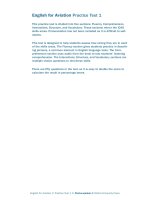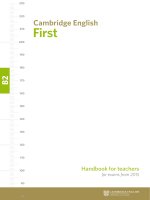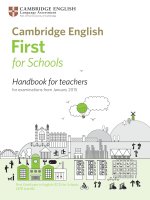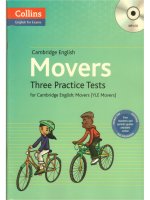Cambridge english first four practice test
Bạn đang xem bản rút gọn của tài liệu. Xem và tải ngay bản đầy đủ của tài liệu tại đây (22.25 MB, 208 trang )
CollinExsams
English for
Cambridge
English
First
Four Practice Tests
for Cambridge English: First (FCE)
Collins
HarperCollins Publishers
1 London Bridge Street
London SE1 9GF
First edition 2015
10987654321
© HarperCollins Publishers 2015
ISBN 978-0-00-752954-4
Collins* is a registered trademark of HarperCollins Publishers Limited
www.collinselt.com
A catalogue record for this book is available from the British Library
‘Typeset in India by Aptara
Printed in China by South China Printing Co, Ltd
Alll rights reserved. No part of this book may be reproduced, stored ina
7
by any means, electronic, mechanical, photocopying, recording or otherwise. wi
the Publisher. This book is sold subject to the conditions that it shall not, by
hired out or otherwise
circulated without the Publisher’ prior consent in any form
in which it is published and without a similar condition includ
this ing
condition beim
purchaser.
HarperCollins does not warrant that www.collinselt.com, 0
title will be provided uninterrupted, that any website will be
or the server that makes it available are free of viruses or bugs, For full
terms provided on the website,
{any copyright holders have been omitted, please contact the Publisher who will m
the first opportunit
Author: Peter Travis
Mlustrators: Aptara
Audio recordings by Dsound and SEA Studios
Photo credits
Contents
Introduction
Guide to Cambridge English: First
fo ct
Reading and Use of English
A
Writing
13
Listening
17
Speaking
21
Paper 1: Reading and Use of English
Paper 2: Writing
26
Paper 3:
Listening
Paper 4: Speaking
Paper 1: Reading and Use of English
Paper 2: Writing
Paper 3: Listening
_ Paper 4: Speaking
aper 1: Reading and Use of English
| Paper2: Writing
Paper
‘Paper
3: Listening
Speaking
38
40
46
48
60
0 prepare for the Cambridge English:
First exarnination
in English or FCE. This book will be useful if yo.
Certificate
am for the first time or taking it again.
The book
and o,
mn designed so that you can use them to study on your ows
the book if you are preparing for Cambridge English:
Firs
- essential advice for success in the exam
English: First- a guide to the exam
to-read guides with brief summaries of the diffe
will help you to understand what you need to know
ons correctly
ons - advice to help you with common problems in «
four complete
self
practice tests with authentic test questions to
with the exam
= definitions of difficult words from the practice tests in this book {the
Collins COBUILD dictionaries}
of what you hear in the Listening paper
ers for the Writing papers and the Speaking
the Listening papers as well as model
0
Introduction
* Start studying early. The more you practise, the better your
English will become. Give
yourself at least one month to revise and complete all the practice te:
sts
in this book.
Spend at least one hour a day studying
+ Time yourself when you do the practice tests, This will help you to feel
more
«OD
confident when you do the real exam
j part in each practice test. Do not be afraid to make notes
"example, writing down the meaning of words you do not know
on the
e
to remember the words later on.
ot studied for Cambridge English: First before, it is recomm
all the practice tests in this book in order. If you have
a
b ok itself.
book will
teac
with speaking and writing, that would be very useful. It is al
dy with other students who are preparing for the exam or whe
ish. Having a study partner will help you to keep motivated. Y
with areas of English you might find difficult. However
an still learn a lot.
r
ibridge English: First by getting to know the different parts o
irt tests, and how many marks there are for each part. Use tt
iction as well as the Quick guides to find out all you can. You
itions section of this book will be useful.
Try to do the
$e will help you to develop the skills you need in order to do
Ng papers. You can improve your writing and speaking
h practice. Practise writing to a time limit. If you
answer of the correct length without
the time gradually until you can write an
u should become familiar enough with your
‘the number of words you have written
at the back of the book. They will
d be like. Do not try to memorise
study hard and do all the
you
need to give good answers
it
king through the onlinetest ang¢,
lun
os
cảm
You can take one of they
version of the test. The other test forms part of»,
test with added tips, advice and infor
so has additional practice materia
g
?
jing module, please turn t
exam will be introduced.
Tt
nediate-level English exam run by
is for people who want to work in
inan English-speaking county. The
ex
lain Suite exams offered by Cambridge English
Introduction
The papers of Cambridge English: First
There are four papers in the exam.
© Paper 1:
Reading and Use of English (1 hour and 15 minutes}
. Paper 2:
riting (1 hour and 20 minutes)
"3: Listening (about 40 minutes, plus 5 minutes for transferring answers to the
eaking (14 minutes]
jare taken on the same day and in the order listed above. Paper 4
cen
a few days before or after the other papers. If you are
d contact your exam centre for dates
studying
f English paper is worth 40% of the total mark, a
pers are each worth 20% of the total mark.
Scale for each of the four skills and Use
‘for your overall performance in the test:
ate stating that you have demonstrated
be awarded a First Certificate in
L, but within B1, you will receive
level.
load the Cambridge English:
Guide to Reading and Use of English
Part 5 (multiple choice) has a text with six questions. You have to answer each question
by choosing the correct answer from four options, A, B, C or D. This part focuses on
Understanding main idea, gist, detail, opinion,
attitude, tone, purpose, meaning from
Part6 (gapped text) has a text from which six
|
12)
(Total marks:
context, implication and text organisation features.
sentences appear in jumbled order at the end of the
shave been removed!
The
by choosing the correct sentence for each gap. This pz
cohesion, coherence and text structure. {Total marks: 12)
Part 7 (multiple matching} has one longer text or several shorter te
‘or prompts. You have to match each question or prompt w
‘sections of the longer text or with one of the shorter texts, A, B, C or D. Tr
`":
opinion, specific information and implicat
ý llenges and solutions
Cha
` of the words in the texts and questions
hen a ‘study to help you to build your F tabutarj, You
sdge English: First. In this book there
Cambri
rd
3/ Wofor
words from the practice tests.
oh
g but try to get a poe
word
din
every
understan
understanding. If there are sections
up the meaning of any words that prevent understanding.
y,
look
difficult
that cause
all the new words or phrases you come across, Try to
SOLUTIONDo: not try to record
focus on high-frequency or common vocabulary.
anc
ses that appear before and after unknown words
Read the sentence with the unknown word carefully.
out the meaning, In
need to read the whole paragraph in order to work ses
might help you
i
ị
\s for how key words and phra
rd is underlined,
to
Examples
The students had different
excuses for not doing their
homework, such as My dog |
ate it’ or My mum washed
itin the washing machine
Reading and Use of English paper tests you
texts on a variety of subjects. The Us:
d and use B2-level vocabulary and gramr
‘the Reading and Use of English paper, you must t
d B2-level vocabulary including phrasal
phrases.
verb
‘usea good range of B2-level grammatical structures
other words
using prefixes, suffixes, etc.
texts such as extracts from fiction and non-fiction books, jo
les, and understand main ideas, gist, details, opinions, at
rases, etc.
, is organised.
within the given time.
g and Use of English
English paper has seven parts.
'cloze) has a short text with eight gaps. You have to completete
word from four options, A, B, C or D. This part focuseson
‘to the line with the gap. This part focuses
estions. Each question has a pair of
has @ gap and there is a given key’ "°°
Is including the ‘key’ word so that fe
Ce, This part focuses on gram
SOLUTION: Prefixe
Aprefix is one or
a word, e.g. unhapi
t
-y, -ment, -hood, th
glish
the meanings and uses ofn Enword
meaning of many unknow
negative meaning
one choice seems correc
n
tha
e
mor
1
t
Par
‘In
2:
E
NG
LE
AL
CH
»
dge of vocabulary and in partic
SOLUTION: Part | tests your knowleocat
Pay attention to the word:
like phrasal verbs, idioms an d coll ion.
because they may be par t of a set expression. While you are
the gap
er than just indiv
exam, keep a record of vocabulary ‘chunks’ rath
in your reading.
idua
note of any interesting ones you come across
SOLUTION: Skip the gaps you do not know and come back to them later. Croe
answer options that you know are wrong so you have fewer options to choos
» CHALLENGE 3: ‘I can't decide what the missing words are in Part 2.’
SOLUTION: Most gaps need a ‘grammar’ word. These are words such as determin
(e.g. a, the, much, manyl, prepositions (e.g. on, at, in] and conjunctions le.g. and,
Ỉ
|
because). Make a list of all the types of grammar words you find in practice test
make sure you understand how they are used.
SOLUTION: Some gaps need words that are part of a set expression. For example,
might have the expressions at least and spend time, and at and spend are in the 9a
‘on the words around a gap and decide if the missing word is part of a set exp
» CHALLENGE 4; ‘I always score badly in Part 3.’
PaTion, Make a section in your vocabulary notebook for word
forming words from some of the words you find. For example
Eat
| lunlbetievabte
Guide to Reading and Use of English
SOLUTION: Read the text before completing any gaps. Identify what kind of word is
‘Missing: noun, verb, adjective or adverb. if it is a noun, should it be singular or plural?
ifitis'a verb, what form of verb do you need? Does the word need to have a positive or
jative meaning?
bể
: ‘How can | learn all the different transforrnations for Part 4”
active to passive or from direct to indirect
book, pay attention to the types of
time to answer all the questions in Parts
ling and scanning skills to find the
read a text quickly, paying attention
‘can often quickly find the important
will save you a lot of time. To be good at
ost important ideas in a text. in the
find important ideas.
es gives you an idea of what the
you do the practice tests and look at your watcy,
n; if you cannot answerj Carryop
spend too lo ing on any one questio
question and w,
This will heli p you not to get stuck on a
YOUr time
urself when
SOLUTION: Time yo
occasionally. Do not
to the next question
using, | ge
d
J: The texts. in Parts 5 and 6 are complicate and conf
_ while I'm reading them.
vn
0L
e r
Look for ‘signposts’ as you read. intThrod
uction
ideas. For example, some words
signal the
of events |
of'Xie...), while others signal a series
of
of a
top
new
ts’ at the beginning
Finally, ...). There are often ‘signpos
agraph as well. If you underst
they can occur in the middle of a par
y
t the text
,ht be able to get a better idea of wha
youdmig
are use
7 “feel
8: ‘None of the answer options in Parts 5 and
» CHALLENGE
in tỉ
mation
SOLUTION: Correct answer options express the key infor
n can b
use different words or ‘paraphrase’ to express it. Informatio
using synonyms (words with a similar meaning) or a different grammati
active to passive, or vice versa). Sometimes, the text gives details but the
option expresses this key information in general terms. Be careful: the sam)
appear in the text can also appear in an answer option. However, this does no
this option is correct. Such options often do not answer the question correctly.
SOLUTION: Cross out any answer options that are clearly incorrect. You are more ikely
to answer the question correctly if you have fewer options to choose from.
SOLUTION: Look for evidence of the answer in the text. For example, if you think an
answer option is correct, find the part of the text where the answer appears, underline
itand fead it carefully. Make sure you are not just matching words in the answer option
with words in the text, or that only part of the answer is correct. This is important in Patt
7, whereyou have to match prompts with sections of a text: a text may have some of the
necessary information but not all.
SOLUTION: The answers to the questions in Part 5 usually appear one after the other in
Hư
sa.
the answ2"
example, you will find the answer to the second question after
.
: the writer’s opinion.
9: 'I find it difficult to identify
’
ý Occasionally, Ũ a question might
writer's opinion is on a subj ect.
ask
hy
the writer wrote the text or SeW
try answeri
You couldee
oon ng
have a better understanding of the whole text
F
such
:
question
i s last
Read articles in Magazines and newspapers. Do not worry abou!
at
ES OE hat every word; such articles will wil be at a fairly high level. Try to 9
the article is about and why the writer might have written \t
Guide to Writing
Quick guide
What is it?
The Writing paper tests your ability to write an appropriate, wel
question using the correct register and format, and a good range
and grammatical structures.
Ja
of 8
Skills needed
In order
to do well in the Writing paper, you must be able to
° understand
the instructions and include all the key points in your answ
* write
a range of formal and
reports. and reviews.
informal texts such as essays, articles,
let!
* use an appropriate register and format.
.
© write a well-organised text that is easy for the reader to follow.
use a good range of B2-level vocabulary and grammatical structures
write your answers within the word limits given in the instructions
* write your answers within the given time.
Paper 2: Writing
The Writing paper has two parts.
Part 1 is compulsory. You have to write an essay in 140-190 words, expressing your
opinion on a given essay title. You are given some ideas which you have to include in
your answer, and you must also include an idea of your own.
In Part 2 you have to answer one question in 140-190 words from a choice of three. The
possible text types are an article, an email, a letter, a report or a review.
Challenges and solutions
CHALLENGE 1: ‘I’m not sure how much time to spend on each question.’
SOLUTION: Know how much time you have. On the day of the exam, wear a watch. While
you work, keep an eye on the time. You can use this guide while you write.
mae Cee Und
Read the instructions carefully and plan your essay.
Write your essay. Make sure you include the ideas you are given as
well as your own idea.
Check your essay carefully for mistakes [e.g. grammar, spelling,
punctuation, word order].
13
BPP
ue
which questi
Read all three questions carefully and decide
answer best.
question yo
Read the instructions dsof the
and think caref (ly abs
Underline the key wor
tto.use—. Then plan your writing
d
a
nee
m
you
r
o
f
.
.
..
“.
sw.er_.
anwer
yorurans
PiWrivateteyou
Check your writing carefully for mistake
ctuation, word order]
punoo
ideas.
‘I'm afraid the examiner will not understand my
ion’ words that connect the ideas in two sentence
despite/in spite of Howe
but Conversely,...
Nonetheles.
Nevertheless,
On the other hand,
tho
In contrast, ....
Furthermore,
._
also
and
Besides that,
In addition, ..__ Moreover,
Asa result,.. Consequently, .
Therefore, ..
inother words
namely
For that reason,
thatis to say
before Finally,... First/Second/Third,
| after assoonas
.. later meanwhile
next soon then
While a few misspelled words will not affect your
‘prevent the examiner from understanding your
‘spelling is to read a lot: the more often you see
il remember how they are spelled.
it text types are organised.”
irst
of the text types you need to be
Handbook
nswers
from the Cambridge
with comments by 2"
s like and how it shoulé
Guide to Writing
» CHALLENGE 4: ‘| don’t know what to write about in Part 1."
SOLUTION: The essay question in Part 1 will give you two ideas to use in your answer. In
order to come up with more ideas, brainstorm the topic:
think about the topic and spend
‘a min
or ute
two writing down all the points you can think of for different
sides of the
argument. When you have finished brainstorming, you can look at the notes you have
nade
and
chose
the best points.
there are no right
or wrong opinions. in other words, you
‘opinions. The important thing is how well you express
are
your
ideas for each topic and give yourself about two t
will get used to thinking of ideas in a limit
‘if | can express an opinion in Part 2.’
e
nt or disagreement in Part 1 and also c
might also need to express your opinion in a letter
are examples of expressions you can use
cation. In the table below
you come across them.
haveE di jifficulty writing
‘IG
EN
+ CHALL7:
essions that native speakers use tom: beginof ang
: There are man y set orexpr
ton something. Learn as any
letters or emails to commen
informal letters or emails.”
nd informal
e below there are some examples of ¢
ions as you c: ‘an. in the tabloss
them
you come acr
Howare you? | hope you're well
Thanks for your letter. It was
[msorry to hear... - fm sop|
It’s great to hear
Write back soon.
See you soon.
Best wishes.
Take care,
|
a record of examples of informal and formal language
a
l
In the table below there are some examples of such
them.
I'm/ You're /It's
lam /You are / It is
I'm up to my ears in work.
am very busy.
was really angry when |
1 was rather disappointed to
discover .
‘putup with
tolerate
Passive
Inversion (e.g. Should you ... Had
|.
o improve my vocabulary for the exam.’
ying
the same things using different words).
f English paper in this book. Then choose a
†
and try to paraphrase what you have
ragraph with the one in the book. Did you
same meaning}? Did you change
Guide to Listening
LISTENING
ic information.
and agreement between speakers
ut 30 seconds) from conversations
lestions. For each question, you
e options, A, B or C. This part
attitude, opinion, purpose and
}
minutes) and ten questions.
tion from the recording. This
inion. (Total marks: 10]
bout 30 seconds) and
a list of eight. This
very useful. By reading
Land you can gu
SOLUTION: The re
below there are some exa
Guessing the meaning of unknown words
Example
Repetition: The speaker repeats a key
word in different sentences.
Re-wording: The speaker rewords a
phrase so that the meaning is clearer.
He/She might use an expression like
the following: By that, | mean . ; What
I'm talking about here is...; In other
words,
Definitions: The speaker might use
an expression like the following to
introduce a definition: This refers to
«i This means....; That's a ..; | think a
Many anim
from p
camouflage
camou
ck ir
usbyestid
Why do companies vet ne
do they perform background
potential employee's history?
It's a matter of agency. | think a definition is
here. Agency is people's ability to make cho
will influence their futures
definition is in order here.
Giving examples: The speaker might
clarify a word by giving examples
which he/she might introduce by using
an expression like the following: like;
such as; for instance/example.
Engaging in recreational activities such as jo991n9
or playing an instrument has been shown to re
stress levels.
» CHALLENGE
2: ‘I get lost when | listen to the monologue in Part 2.’
SOLUTION: The questions follow the order of the information in the recording. Use
pause before the first listening to read all the questions. Underline key words
for them when the recording starts. Using the questions as a guide in this wey
you not to get lost when you listen.
Listen for ‘signposts’ (words or phrases that signal that th
u
of information). Some ‘signposts’ signal the intr
to....). Others signal the definition of a
osts, you can get a better idea of what
y focused. To practise, listen to the re
Guide to Listening
down all the ‘signpost’ words you hear. Then check your notes against
How many did you notice?
write too many words when | complete the sentences
ite each sentence with a single word, a short phrase
ithis. The missing words are the same as ones you
ave to Write a different word or number. However,
Not be in the same order or even the same
, itis important to listen for meaning and not
1 a similar meaning] or a different
imes, the recording gives details
|
|
|
and cross out the ones that are,
SOLUTION: Read the answer options carefully
You are more likely to answer
incorrect or that do not answer the question.
:
choose from
correctly if you have fewer options to
ify a speaker's opinion o;
SOLUTION: Some questions ask you to ident
they give an opinio:
the different expressions that speakers use when
my opinioi
question, \f yc
SOLUTION: Do not spend too much time answering any one
the most appea
certain of an answer, choose the answer option that is
ct
to the next question. If you spend too long worrying about the corre
not hear the answer to the next question.
» CHALLENGE 5: ‘I don’t always understand the speakers. Sometimes the
fast.”
SOLUTION: Listen as much as possible to natural English.
T
English speech, the better you will understand the English used
following:
or films. The programmes do not have tc
h
TV programmes
* Watc
_ comedies and dramas have good examples of natural English
English-language films with subtitles. Listening can be ez
eck
understanding.
Jage club. Your university, local library or communit
ing,
you will be able to practise speaking Englis
nity. There may be native speakers of En
d will be happy to practise talking to you us
radio programmes that you
“only a minute or two at 2 *
1
fas many
times 2s)
Guide to Speaking
SPEAKING
|
|
Quick guide
What is it?
The Speaking paper tests your ability to understand and use spoken English. You will
take the Speaking paper with another candidate, although there is a small chance that
you will take it with two other candidates.
jo well in the Speaking paper, you must be able to
d and use the language of social interactions.
d compare.
ur opinion.
ct and come to a decision.
| range of B2-level vocabulary and grammatical structure
hts and express them clearly.
etc. This part focuses on general
minutes]
raphs and asks you to describe and
other candidate two different
andidate has finished speaking, the
to speak for 30 seconds.
and organising speech.
| and then come to a decision
and justifying
Challenges and solutions
ner's
>» CHALLENGE 1: ‘I'm not sure how much to say when | answer the exami
in Part 1.’
‘questions
This part is just a simple conversation between you and the exarn
i
chance
for him/her to get to know more about you. You do not have to give long
but you should say more than ‘Yes’ or ‘No’. When you answer Part 1 question. Give
reason for your answer or an example. For example:
What kind of food do you like to eat?
Examiner:
Candidate: —_/ enjoy Indian food. There's a really nice restaurant near my house 5,
¬
always order something spicy to eat when we go there.
» CHALLENGE 2: ‘I'm not sure I'll have enough to say in Parts 1 and 4.
SOLUTION: The questions in Part 1 are about you and your experienc:
your
might ask you to talk about your hobbies and interests, where you live,
studies, etc. and you already know a lot about these subjects! Look at th
Think about the kind of questions the examiner might ask you about the
how you would answer them.
fs
Peet cei)
Do many tourists visit your town?
Where you live
_| Your hobbies
or interests
ds and family
routine
Have you always had the same hobbi
Who do you look like in your family?
What time do you like getting up?
What was/is your favourite subject at school?
Have you read a book lately that you really enjo
What kind of food do people in your country
use the same words and phrases all the time. For exampl
like or don't like:
.......* I can't stand...
____*
] fan of...
a big
I'm [not
I'm not that bothered
about.
Guide to Speaking
‘opinion one way or the other. | Suppose ...
‘of the opinion that...
thought to. Perhaps...
Means you must listen carefully to what he/she
‘questions’ appropriately. These are useful in Part 3 and
‘that | won't
have enough time to finish talking in
1 won't have enough to say!”
ise for Part 2 so that you get a good idea what
Jo the speaking tasks in this book and find more on
jhile you practise, you will learn not to speak too fast or
to give a complete answer within the time allowed.
| worried that my description will be disorganised and
lâm
for your description. Here is a suggestion:
is about. For example: These photographs show
like a children’s birthday party .
h and what they are doing. For example:
Some are sitting at a table and the adults are
describing what some of them are wearing
cont"
but remem ber to compare and
h
rap
tog
pho
ond
sec
me for the
5 ws people celebrating but tp
7/ she second photo also sho
e:
pl
am
ex
For
.
;
es
en
sc
ae
first photograph, all the people
the
h
wit
st
ra
nt
co
In
on.
asi
occ
Tees work-related
Ễ
For example: The fi
by commenting on t he scene.
« Ifyou have time, finish
ties | had as a child.
_ ch me of the birthday par
expressions that you can u
SOLUTION: There are many words and ow there are some common
ganise your thoughts. In the table bel
‘or
rn them.
words and expressions as you lea
However,
a though
Comparing
but
compared to
On the one hand,
On the other hand,
Giving reasons
because
s0
because of
in order to
Giving examples
for example
for instance
To give you an example
The first reason is...
What's more, .
The second reason is . .
Finally, .
Soall in all, ..
In general,
Also, ...
To sum up, . .
il
ition
is bad.”
The examiner does not expect you to speak with a native speaker
accent is not regarded as a problem, even at a higher level
speak clearly so that people can understand you easily.
cording of you speaking English. They might be able
problems you have. In particular, ask them if it is e:
1g. What words do they have difficulty understand
of your voice with that of the n2t
ion of the native speaker? K&
|
Guide to Speaking
SOLUTION: Practise speaking English with native English speakers. To find native
English speakers in your area, try going to tourist attractions in your city. You could also
join an English language club at your school. If your school does not have one, check at
your local library or start one yourself!
¬
:
SOLUTION: Some speakers have trouble with certain sounds. For example, Spanish
speakers sometimes add e to English words beginning with s, e.g. ‘eschool’. Other
speakers pronounce the letter was av. Find out if speakers from your country ha
particular problem with English pronunciation and practise that area
If you want people to understand you when you speak, you have to stress
Ifyou stress the wrong syllable, people might not understand you. For
ing nouns, the underlined syllable is stressed:
J
yourself when you make a mistake is a good way of showing the
est to correct some mistakes but try to relax and speak as
English as much as you can before the exam. One way
lf when you are alone. The advantage of being alone is
ha
ess worried about making mistakes. Talk about what has
your plans are for the rest of the week or your opinion of









